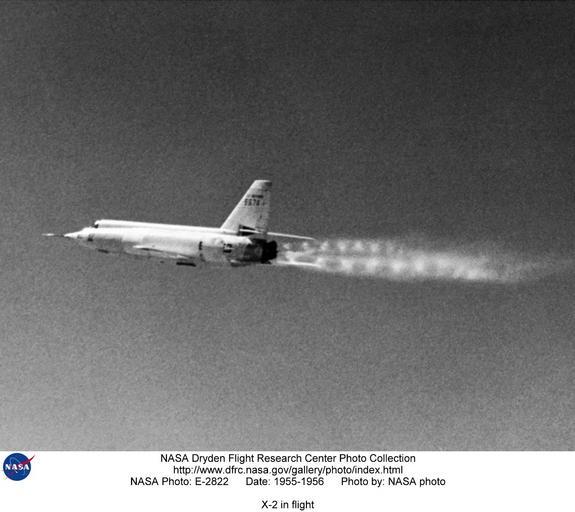MAKE A MEME
View Large Image

| View Original: | X-2_in_flight_DVIDS714341.jpg (1536x1367) | |||
| Download: | Original | Medium | Small | Thumb |
| Courtesy of: | commons.wikimedia.org | More Like This | ||
| Keywords: X-2 in flight DVIDS714341.jpg en This inflight photograph of the X-2 46-674 shows the twin set of shock-diamonds characteristic of supersonic conditions in the exhaust plume from the two-chamber rocket engine The Curtiss-Wright XLR-25 rocket engine caused one of several problems that delayed flight of the X-2 At one point people in the project suggested its replacement It was the first man-rated in the terminology of the day rocket engine that was throttleable and the technology was not yet mature Other problems included the X-2's landing gear and the replacement of the planned electronic flight controls with a conventional hydromechanical system like that used in the F-86 The X-2 was a swept-wing rocket-powered aircraft designed to fly faster than Mach 3 three times the speed of sound It was built for the U S Air Force by the Bell Aircraft Company Buffalo New York The X-2 was flown to investigate the problems of aerodynamic heating as well as stability and control effectiveness at high altitudes and high speeds in excess of Mach 3 Bell aircraft built two X-2 aircraft These were constructed of K-monel a copper and nickel alloy for the fuselage and stainless steel for the swept wings and control surfaces The aircraft had ejectable nose capsules instead of ejection seats because the development of ejection seats had not reached maturity at the time the X-2 was conceived The X-2 ejection canopy was successfully tested using a German V-2 rocket The X-2 used a skid-type landing gear to make room for more fuel The airplane was air launched from a modified Boeing B-50 Superfortress Bomber X-2 Number 1 made its first unpowered glide flight on Aug 5 1954 and made a total of 17 4 glide and 13 powered flights before it was lost Sept 27 1956 The pilot on Flight 17 Capt Milburn Apt had flown the aircraft to a record speed of Mach 3 2 2 094 mph thus becoming the first person to exceed Mach 3 During that last flight inertial coupling occurred and the pilot was killed The aircraft suffered little damage in the crash resulting in proposals never implemented from the Langley Memorial Aeronautical Laboratory Hampton Virginia to rebuild it for use in a hypersonic Mach 5+ test program In 1953 X-2 Number 2 was lost in an in-flight explosion while at the Bell Aircraft Company during captive flight trials and was jettisoned into Lake Ontario The Air Force had previously flown the aircraft on three glide flights at Edwards Air Force Base California in 1952 Although the NACA's High-Speed Flight Station Edwards California predecessor of NASA's Dryden Flight Research Center never actually flew the X-2 aircraft the NACA did support the program primarily through Langley Memorial Aeronautical Laboratory wind-tunnel tests and Wallops Island Virginia rocket-model tests The NACA High-Speed Flight Station also provided stability and control recording instrumentation and simulator support for the Air Force flights In the latter regard the NACA worked with the Air Force in using a special computer to extrapolate and predict aircraft behavior from flight data NASA Identifier NIX-E-2822 2009-09-23 Glenn Research Center https //www dvidshub net/image/714341 714341 2012-10-10 17 39 WASHINGTON DC US PD-USGov Aircraft at Rogers Dry Lake Images from DoD uploaded by Fæ Bell X-2 | ||||